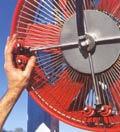Engineers continually push boundaries. George Eady, from Hope on the waimea plains has enthusiastically worked to improve the efficiency of horticultural spray application technology for the past eight years, and his leading edge Quantum Mist spraying systems are beginning to attract significant attention from horticultural enterprises from all over New Zealand, Australia and more recently breaking into the United States market.
George and his wife Pat, returned to the south island 15 years ago, with a background in manufacturing automotive components, they got involved in a young apple orchard where they built their home and a small workshop.
"The first thing we found when we were learning to grow apples was that there was no actual book, there seemed to be no courses where you could learn it all. Our neighbours, our packhouses and those sort of people were very supportive, as was ENZA, but we quickly found that a lot of it was 'we did what every body else did, because that's what everybody did'. Very early on I found that the spraying was an expensive part of our business, it took a long time and it seemed to be very much overkill."
They got involved with Nelson Group 8 Horticulture Ltd., a group of like minded growers in the area who were concerned with getting the best performances out of their orchards. The group employed a full time consultant and an important area highlighted for improvement was the efficiency of spraying and that task was delegated to George due to previous involvement, and this instigated detailed research.
"The technology we used initially was existing technology from all over the world, but we found that for our Nelson and New Zealand conditions, it wasn't suitable. It wasn't robust enough and it couldn't counter our winds and breezes."
George tried initially to build his own complete sprayers but competing with the large existing manufacturers was not viable. It was decided to purchase existing non critical components such as tanks, chassis and pumps, and focus on the design of hydraulically driven fan spray heads and their supporting frames. Reliability and ease of maintenance have always been key factors.
"The idea with the whole thing is to use standard industry components that can be serviced locally if required. Being a farmer myself I also wanted adjustments to be made with a single spanner, you can always lay your hand on at least one spanner!"
The past eight years have seen a rigorous process of testing, evaluation and constant improvements to the QuantumMist TM spray units. They offer a wide range of sprayers catering to a range of crop types, from new units to retro fitted devices attached to air blast sprayers, while taking orders for specific and unique crop applications, the main advantage is the ability to accurately target crop pests.
"It's an ongoing challenge to keep improving things. There is a lot of pressure on apple growers and other fruit growers from our overseas customers for a cleaner environment with less spray with sustainable horticultural practices. It's better that we spray less and to do that we need efficient sprayers."
"In grapes and berries and so forth, we can specifically target where that disease or pest pressure is at that stage of growth, later on in the season that may change to higher or lower in the canopy and it's a two minute job to adjust it to suit."
This can also allow more hectares to be sprayed per hour with a reduction in water rates. Although George is quick to point out he is not advocating reduced chemical usage, saying this is best left to the entomologists, it can create savings of up to 50% in chemical usage in some situations. The spray head nozzles are changeable, fully adjustable and apply a saturating fine mist. The fans have six blades at a 25 degree angle running at 2,500rpm which gives 14,000 cubic meters of air an hour, providing high volume, low pressure very turbulent air that remains in the crop canopy for some time.
When the heads are assembled they are put through rigorous hydraulic testing to ensure they reach the required specifications, with all numbers registered. With new developments, nothing goes out without being internally and field tested for at least one season as a minimum. And George prides himself on a personal service.
"When we sell a unit locally, I'll go out and help install it, train the operator and set it up for optimum performance. It's important that people have an understanding of the new technology, and that they operate it correctly to take full advantage of all the benefits."
